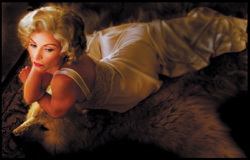The Soul of Art Photography
For me, the black-and-white image has always been the core, the essence, and the soul of photography. It’s almost as if there is more honesty in a black-and-white print than there is in a color one. In a color print, you’re never sure if the color you see is the color the photographer saw. Black-and-white reveals the truth of subtle shade and tonal shifts. It has a simplicity, elegance, and beauty that defy description.
The magic in watching a black-and-white image appear in the developer tray, along with the smell of stop bath and fixer, is what sparked my desire to be a photographer. My formal education in photography was in large-format black-and-white nature photography. Before 1998, the year I went totally digital, I was shooting some 6000 rolls of film per year, of which 90% were black-and-white. At the time, I made my living doing head shots for Hollywood actors, and those were always shot and printed in black-and-white.
When I started beta-testing some digital photography equipment in 1992, I was told I had to start shooting color if I wanted to be a beta site for any future devices. So, of course, that’s what I did. What surprises me is that I’m now better known for my color images than for my black-and-white ones. No matter; black-and-white remains my first love.
As I entered the digital world, black-and-white prints took a backseat to the new art of digitally capturing color images and to the concerns of how to best produce a print that remained true to my vision. One of the basic tenets of my training as a photographer was derived from an Ansel Adams quote: “The negative is everything, the print is all. The negative is the sheet music and the print is the symphony.” That is, the print is the culmination of the effort, the thing you can show to others and sell.
A World of Shadows
In the film world, to make a print worthy of showing to others, you must have a worthy negative. In the digital world, the negative is a file. That file has to contain quality information, or the print that you create from it will be poor. Without good sheet music, the symphony will be worthless.
But what if you have great sheet music, but can no longer create a great symphony from it? Until recently, this was the sorry state of affairs that existed for the great black-and-white negatives produced by such photographic icons as Ansel Adams, Minor White, Edward Weston, and Wynn Bullock. Their prints—the ones with which we fell in love—were made on papers that are no longer available. Today’s photographic papers no longer contain heavy metals like cadmium and mercury. OSHA and the EPA have ordered them removed for environmentally sound, but not necessarily aesthetically good, reasons.
Ironically, these same heavy metals made the older papers archivally stable and gave them great maximum densities. Today, when it comes to silver printing, you can achieve a similar result using selenium-toned papers to regain image stability and maximum density.
Also, the photographic papers commercially available today contain less silver than they once did. Unless you’re willing to invest the time and expense to create platinum or other alternative-process prints, it’s very hard to capture the subtleties and full range of tones within a black-and-white negative on commercially available, silver-based photographic paper. That’s the bad news. The good news is that digital cameras, software, and inkjet printing technologies let us create black-and-white prints in ways we no longer thought were possible.
A black-and-white print isn’t purely black and white; it’s made up of monochromatic tones. Many variables affect the final tone of a black-and-white print. For one thing, each type of silver-based paper produces a print with a characteristic tone. For example, Agfa Insignia, Agfa Portriga, and Forté Salon are warm-tone papers. Oriental Seagull, Agfa Brovira, and Ilford Galerie are cool- to cold-tone papers. Different developers and developer concentrations can also change a print’s tone, as can selenium toning.
In the old days, when we were printing on silver-based papers, we chose a particular one and processed it in our individual way in order to achieve a specific tonality that only we could achieve in our secret darkroom dance. We wanted to make a warm- or cold-toned print with rich, deep blacks, detail in the textured blacks or deep shadows, and crisp, textured whites in the highlights. We wanted a print that had a complete tonal range from dark black to pure white, and that goal hasn’t changed.
Learning the R-G-Bs
Now that I’ve defined what’s desirable in the print—the type of symphony you want to create—let’s look at what constitutes a black-and-white capture on film, and which of its characteristics you want to replicate. It’s time to learn how the sheet music is written.
Panchromatic black-and-white film (pan means “all” and chromatic means “colors”) is the film type that is most often used to take black-and-white photographs, because it records light in the range visible to the human eye. Visible light, which is measured in nanometers (nm), is in the 400–700 nm range. A general approximation is that blue ranges from 400 to 500 nm, green from 500 to 600 nm, and red from 600 to 700 nm. The human eye is most sensitive at 555 nm, right in the middle of the green spectrum.
When the mix of colors (or relationship between colors of light) changes, film can record that change. When you enter the digital world, things are different. Digital cameras record the relationships among red, green, and blue light within the image. Red, green, and blue are words used to describe three independent wavelengths of light. Any color that you capture with a digital camera can be defined by its mixture of red (R), green (G), and blue (B) light, and by its profile.
Without explicit reference to an RGB profile—such as Adobe RGB (1998), for example—RGB is meaningless; you simply have no idea what the colors really are. Without a reference RGB profile, all you know is that the red is some shade of red and the green is some shade of green. With a reference RGB profile, you know what those particular shades are.
Film works with density and digital cameras work with luminance, so they have different RGB responses and tone-reproduction curves. Images captured on film will look different from those captured with a digital camera.
Images captured with digital cameras produce digital values relative to the scene luminance as automatically calculated by the camera’s tone-reproduction curve. This means that equal changes in scene brightness will produce equal changes in digital values.
Black-and-white film has the ability to record the ever-changing relationship of visible light, and digital cameras record the relationships among R, G, and B. Therefore, it’s critical to maintain that relationship when converting a digitally captured image from color (Figure 5.1) to black-and-white (Figure 5.2) if you want to replicate the look and feel of traditional black-and-white film photography. Bear this in mind when post-processing digital camera images in Photoshop to achieve the look of a classic black-and-white image.
RGB Isn’t a Color, It’s a Formula to Mix Color
Another factor to consider is that film, digital cameras, and people all see the colors in a scene differently. There are many reasons for this, but two of the more significant ones are the spectral sensitivities and tone-reproduction curves that are unique to each medium. Every film type has unique RGB characteristics because of its photographic emulsion chemistry. Each digital camera type has unique RGB responses and tone-reproduction characteristics because of its RGB sensors and filters, as well as its signal (image) processing characteristics.
Neither film nor digital cameras reproduce color the way the human eye sees it. The eye has unique color and tone responses. Film and digital cameras attempt to approximate the way people see color; but, as is always the case, there are design trade-offs that compromise this goal.
So what is RGB, really? If you walk away from this lesson having learned only one thing—aside from how to make a great black-and-white print from a color capture—it should be this: RGB isn’t a color, it’s a formula to mix color.
Go to the Channels palette in Photoshop. You will see four channels: RGB, Red, Green, and Blue. If you look at the Red, Green, and Blue channels individually, what you will see is not color, but gray. You will also see that each of these channels yields different intensities of the grayscale for each color in each area of the picture (Figures 5.3, 5.4, 5.5, and 5.6).
Figure 5.3. All channels.

Figure 5.4. Red channel.

Figure 5.5. Green channel.

Figure 5.6. Blue channel.

Note
The keyboard shortcuts for seeing the Red, Green, and Blue channels individually, as well as the one that shows all three, are: Red: Ctrl-/Cmd-1, Green: Ctrl-/Cmd-2, Blue: Ctrl-/Cmd-3, and to see all the channels at once (or RGB, as it is referred to in the Channels palette): Ctrl-/Cmd-~.
Two Ways Not to Convert RGB to Black-and-White
Before you do this lesson, I invite you to experiment and try creating a black-and-white image in the following two ways.
First, globally desaturate the image with Image > Adjustments > Desaturate, then look at the three channels separately. (See above note on how to do this.) You won’t see any difference in the image, and when you turn on all three channels, all you will see is a slightly denser image. This approach destroys two-thirds of the spectral relationship and wipes out the relationships among red, green, and blue.
Second, do a “classic” black-and-white conversion. Go to Image > Mode and convert the image from RGB to LAB color mode. Then go to the Channels palette, and throw away the A and B channels. Go back to Mode, convert the image from LAB to grayscale, then go to Mode again and convert the image from grayscale to RGB. Now, look at the Red, Green, and Blue channels. Again, there is no change. Basically, you have duplicated the luminance channel three times, and again destroyed two-thirds of the relational spectral data, albeit to a lesser degree.
These two approaches produce digital black-and-white prints in which some element of visual richness is missing. Those missing elements are the spectral relationships among R, G, and B. Preserving those relationships is the aim of the three conversion methods I will discuss next.
